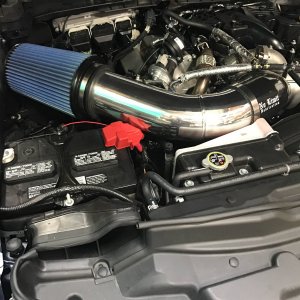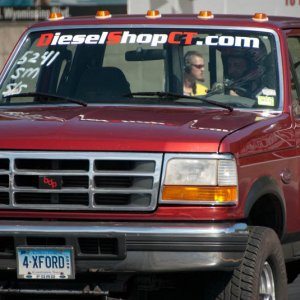Let me assure you I did not know who Colt, RCD, or Elite was. When I started on this stuff 3 years ago I started with a clean slate and honestly did not care what he OEM cam was nor what was out there. This is stuff is not rocket science....a diesel is an air pump in constant detonation. A cam is needed to supply demand that comes from the air pump for a given rpm range.
Turbo engine gas or diesel are driven by exhaust velocity. The highest velocity reached on the exhaust side is when the valve is open. You want hit that thing hard and quick and shut the valve and continue to do that with each cylinder. Hanging the valve open for longer than is needed is not how you do this. Increasing exhaust duration, time, does not do this. I have not found one engine among the 3 "Tribes" that needs longer duration on the exhaust. If you extend the time of the exhaust valve being open to long all your doing is reducing velocity and helping to cause turbo lag.
The duration on exhaust on this cam is shorter....less than intake. The duration on my Duramax is less on exhaust. The duration on my Cummins is the same at .050" on intake and exhaust. Now on the Cummins, this does not mean it is the same lobe.
In almost any engine application, since the max exhaust velocity happens at low lift, the rate of decrease of lobe area on the exhaust should be greater than the intake. This is most important in a turbo engine as you want to keep the turbo spooling.
Events. In a turbo engine the OEM's open the intake valve early to allow fresh air to mix during overlap and go out the exhaust. This allows for a cleaner exhaust out the pipe. This is not a good way to make power as you have boost working against mechanical force and the more boost you put in the engine the more this battle is increased. For those of you that have bent pushrods, broke cams, cracked pistons....the cause is this internal battle.
To make power in a turbo engine, you want to open the intake valve when the piston is at TDC. Doing this, you stop the internal battle and now you assist the piston and blow it down the cylinder helping the engine to accelerate.
Size Doesn't Matter. At the end of the day we make power with cylinder pressure. The goal in any combustion engine is to maximize the explosion and we do this with pressure. The one that makes the most pressure wins. Duration and lift are just part of the equation, it is the events that control what we trap for combustion. If you can fill the cylinder quicker then you will need less lift and less duration. If you over cam an engine you have just wasted time.
Please don't take what I said as an accusation of being a copy cat. Just trying to make a broad comparison in the hopes it would spur discussion about your process. I learn by reading, and then projecting my interpretation of the information to those who know more than me, and seeing what I got right and what I got wrong.
I'm pretty much in agreement with your rational regarding the intake side. I think the key words you used were "for a given RPM range." My understanding of it is that if your RPMs are high enough, the period of time where you are opening the intake ports during the exhaust or compression cycle are small and wont result in a waste of intake air going out the exhaust port or much fighting against the intake stroke. In the same breath, your window for intake isn't very large either, which is why you want an adequate opening for the desired air flow for as much of the intake stroke as possible. Of course, this is half of what results in choppy idle with a high rpm cam.
I can only think of one possible exception to this. My line of thinking is that the piston is effectively lowering the intake manifold pressure temporarily due to less resistance to flow during the intake stroke (and of course sucking out the mass of air). So long as the turbo is supplying air to the intake manifold, would the cylinder still breath in air through the intake port during the compression cycle until the pressure caused by cylinder compression and the pressure produced by the turbo reach a state of equilibrium? In case this explanation of my thoughts is confusing, I'll try an example with very easy numbers. Lets say the intake manifold has .25lbs of air at 40psi. Intake stroke occurs and draws .2lbs of air and a cylinder pressure of 30PSI by BDC. In this time, the turbo has supplied another .2lbs of air to the intake manifold and was able to hold 40PSI Intake Manifold Pressure for the duration of the intake stroke. Wouldn't the cylinder continue to draw air until both the pressure in the cylinder and the pressure in the manifold are both 40PSI? In my mind this is the point where you'd want the intake valve to finally close in order to prevent air being pushed back into the intake manifold by the cylinder.
I understand this is a resistance your engine needs to fight against, but in the same vein more air means more fuel can be burned so you'd get more power. I also understand that this point of equilibrium, if this is in fact how it works, will vary depending on how well your ports flow air, how much air your turbo flows, the resulting pressure ratios, etc. In my mind a setup with a turbo that flows more air and builds more pressure could likely go deeper into the compression stroke than a setup with a smaller turbo that flows less, all other things being equal. You could say the same thing about more restrictive ports, a log style intake manifold vs. just pipes, different cylinder displacements, etc. Of course, most of us won't be able to go through the math to figure out what is just right, nor have the patience/money to keep trying over and over again to get a perfect cam when reality gets in the way of math. I believe this is why most other companies offer various stages of cams, so consumers have an option that will be "close enough."
For the exhaust side of things, I have to disagree with your premise. I think the heat caused by forcing the air through the valves over a shorter period of time is the factor that affects turbo spool, not the velocity of the air through the ports spinning the turbine faster.
At the end of the day, what drives the turbo is the pressure ratio before and after the turbine. The higher the pressure ratio, the faster the turbine spins because there is more force acting on it. What affects the pressure ratio is how much air is moving, the temperature it is at, and the size of your turbine housing A/R. Suppose the engine is moving 50 lbs of air per minute, no matter what (wastegates aside), there is 50lbs per minute of air moving across that turbine wheel. If, before going to the turbine, the air travels through a large diameter pipe, and then a large diameter a/r, it's going to have lots of space to linger, cool off, and generally take it's time. There wont be a high pressure ratio across the turbine, so it will move slowly through the turbine, meaning the turbo wont be spooled very fast. The complete opposite is true if you have tight exhaust plumbing and a tight A/R to the turbo.
Because you are going from the cylinder (a big space) through the exhaust ports (a little space) to the exhaust manifold (a big space), you are going from low velocity to high velocity to low velocity again before you even reach the turbo. I believe you are right that there is some momentum in the air coming through the exhaust valves, but I don't believe it would be a significant factor unless you were dealing with a very tight exhaust system where the exhaust manifolds and up pipes aren't acting like a sink.
Where I do think it matters is temperature. if your valve lift duration is shorter, there will be less time for the air to squeeze through the valves and the ports. it will result in more pressure which results in heat. Of course once you get to the exhaust manifold, the heat from compression through the valves = greater pressure than what you would have got from the combustion temperatures alone, which means your P/R over the turbine should be higher.
But, most of us don't want high EGTs, at least not in the cylinder. By opening up the exhaust valve sooner, even before BDC during the combustion stroke, the window to get the air through the exhaust ports is longer, meaning less in-cylinder pressure and temperature. You still get the same airflow over the turbine, and you still have heat from combustion contributing. Hell, that could be the rational for opening the exhaust valve during the combustion stroke; less time for the air to lose heat to the cylinder head, piston, and block.
If that theory is correct, then it means there are two successful methodologies for increasing spool via a change in a cam's exhaust profile. Of course, my ideas could be completely out to lunch. If so, I hope you are willing to explain why so that I may better understand the theory.












